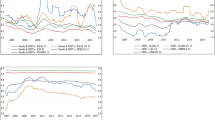Abstract
According to the Federal Reserve Board, banking firms have recently been shifting significantly larger portions of their loan portfolios into real estate. This increase in real estate lending has caused concern about the continuing economic health of banks on the part of state and federal regulators, since changes in real estate returns, evidenced by changes in property value, can potentially have a significant impact on bank default risk and profit-ability. However, concerned parties do not seem to have explicitly considered the relationship between mortgage default risk and the specific characteristics of real estate investments.
This study examines the sensitivities of stock returns for different bank groups, based on the percentage of total loans in real estate and the percentage of loans in five different mortgage categories (construction and development loans, farmland loans, one- to four-family residential loans, multifamily residential loans, and nonresidential and nonfarm loans), to changes in real estate market returns. This is done by developing and using a three-index model.
The results of this study indicate that bank stocks, overall, are very sensitive to changes in real estae returns. Banks, with a larger portion of their total loans invested in all types of real estate loans, except farmland loans, are most sensitive to changes in real estate returns.
Similar content being viewed by others
References
Anderson, D.R., and M. Weinrobe. (1986). “Mortgage Default Risks and the 1971 San Fernando Earthquake,” AREUEA Journal 14, 110–135.
Board of Governors of the Federal Reserve System. (1980). “The Depository Institutions Deregulation and Monetary Control Act of 1980,” Federal Reserve Bulletin (June), 444–453.
Booth, J.R., and D.T. Officer. (1985). “Expectations, Interest Rates, and Commercial Bank Stocks,” Journal of Financial Research 8, 51–58.
Campbell, T.S., and J.K. Dietrich. (1983). “The Determinants of Default of insured Conventional Residential Mortgage Loans,” Journal of Finance 18, 1569–1581.
Chance, D.M., and W.R. Lane. (1980). “A Re-Examination of Interest Rate Sensitivity in the Common Stocks of Financial Institutions,” Journal of Financial Research 3, 49–55.
Flanners, M.J., and C.M. James. (1984a). “The Effect of Interest Rate Changes of Common Stock Returns of Financial Institutions,” Journal of Finance 39, 1141–1153.
Flannery, M.J., and C.M. James. (1984b). “Market Evidence on the Effective Maturity of Bank Assets and Liabilities,” Journal of Money, Credit, and Banking 16, 435–445.
Furstenberg, G.M., and R.J. Green. (1974a). “Estimation of Delinquency Risk for Home Mortgage Portfolios,” AREUEA Journal 2, 375–384.
Furstenberg, G.M., and R.J. Green. (1974b). “Home Mortgage Delinquencies: A Cohort Analysis,” Journal of Finance 24, 1545–1548.
Hartzell, D.J., and J. Fernald. (1987). “A Recent Innovation: Creating High-Yielding Synthetic Commercial Mortgage-Backed Floating Rate Bonds Through Interest Rate Swaps,” Housing Finance Review 6, 73–77.
Hill, E.W., and R.J. Vaughan. (1992). “The Impact of Commercial Real Estate on Bank Portfolios.” Appendix D in Banking on the Brink: The Troubled Future of American Finance. Washington, D.C.: Washington Post Briefing Books.
Ibbotson Associates. (1992). Stocks, Bonds, Bills, and Inflation. Chicago.
Kmenta, Jan. (1986). Elements of Econometrics. New York: Macmillan Publishing Company.
Kwan, S.H. (1991). “Re-Examination of Interest Rate Sensitivity of Commercial Bank Stock Returns Using a Random Coefficient Model,” Journal of Financial Services Research 5, 61–76.
Lynge, M.J., and J.K. Zumwalt. (1980). “An Empirical Study of the Interest Rate Sensitivity of Commercial Bank Returns: A Multi-Index Approach,” Journal of Financial and Quantitative Analysis 15, 731–742.
Mei, Jianping, and A. Saunders. (1991). “Bank Risk and Real Estate: An Asset Pricing Perspective,” Working paper, New York University.
National Association of Real Estate Investment Trusts, Inc. (1992). REIT SOURCEBOOK: A Complete Guide to the Modern Real Estate Investment Trust Industry. Washington.
Quigley, J.M., and R.V. Order. (1990). “Efficiency in the Mortgage Markets: The Borrower's Perspective,” AREUEA Journal 18, 237–252.
Scott, W.L., and R.L. Peterson. (1986). “Interest Rate Risk and Equity Values of Hedged and Unhedged Financial Intermediaries,” Journal of Financial Research 9, 325–329.
Author information
Authors and Affiliations
Rights and permissions
About this article
Cite this article
He, L.T., Myer, F.C.N. & Webb, J.R. The sensitivity of bank stock returns to real estate. J Real Estate Finan Econ 12, 203–220 (1996). https://doi.org/10.1007/BF00132268
Issue Date:
DOI: https://doi.org/10.1007/BF00132268



